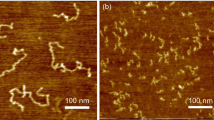Abstract
The conformational properties of a lattice self-avoiding polymer chain tethered to an interacting and impenetrable flat surface were simulated using a dynamic Monte Carlo method. The results show that the conformational size reaches a minimum at the critical adsorption point (CAP) and that the scaling behavior of the polymer at the CAP is the same as that in the bulk solution. The results provide a new method to determine the CAP of polymer chains.
Similar content being viewed by others
Introduction
The adsorption of polymer chains on surfaces by means of physical or chemical interactions is an important subject in polymer and biological sciences. A polymer chain may adsorb or desorb, depending on interactions with the surface. This phenomenon is relevant to many technological applications such as in polymer compatibilizers, colloid stabilizers and polymeric surfactants.1, 2, 3 In many biological systems, ligands are attached to a surface through flexible tether chains.4, 5 The conformation of the attached tether chains will affect the binding of the ligand to a receptor and will thus influence the whole biological process.6 The adsorption phenomenon is also a part of many physical systems; for example, polymer chains grafted to colloid particles and block copolymers at liquid–air interfaces.7 The adsorption of polymers has attracted a large number of theoretical and experimental studies.7, 8, 9, 10, 11, 12 The growing interest in polymers interacting with substrates warrants a thorough understanding of the static and dynamic properties of the tethered chain.
A mathematical model often used for studying the adsorption of tethered polymers on surfaces is the self-avoiding walk (SAW) chain in a three-dimensional (3D) simple cubic lattice that interacts with a flat surface and is restricted to lie on one side of the surface.13, 14, 15, 16, 17 Every walk step that contacts the surface is assigned an interaction energy ɛ (in units of kBT, where kB is the Boltzmann constant and T is the temperature). It is well accepted that a single chain adsorbed on an attractive surface exhibits a phase transition from a desorbed state to an adsorbed state when the adsorption strength increases beyond a critical value. The CAP ɛc was estimated to be about −0.29 for polymers on the simple cubic lattice.9, 10, 11, 12, 16, 18, 19
In this work, we studied how the conformational properties of the chain change from a desorbed state for ɛ>ɛc to an adsorbed state for ɛ<ɛc. We found that both the mean square end-to-end distance 〈R2〉 and the mean square radius of gyration 〈RG2〉 have a minimum near ɛc. The conformation size 〈R2〉 and 〈RG2〉 increase rapidly when ɛ<ɛc. The scaling law  holds for every interaction energy ɛ we investigated. The exponent νR is dependent on ɛ. We found a minimum νR≈0.6, equal to that in bulk solvent, at a CAP ɛc≈−0.29. This result provides a new method to determine ɛc in experiments and simulations.
holds for every interaction energy ɛ we investigated. The exponent νR is dependent on ɛ. We found a minimum νR≈0.6, equal to that in bulk solvent, at a CAP ɛc≈−0.29. This result provides a new method to determine ɛc in experiments and simulations.
Model and calculation method
Simulations were performed on a simple cubic lattice. The flat surface was assumed to be infinitely large, impenetrable to the polymer chain, and located at z=0, with direction z being perpendicular to the flat surface. The lattice layers above the surface were numbered z=1, 2, …. A SAW polymer chain comprises n identical, consecutively linked monomers with a bond length of one lattice unit. The first monomer of the chain was fixed at position (0, 0, 1) and was considered to be adsorbed to the impenetrable surface. We used a large simulation box to eliminate the size effect. The simulation sizes in the x and y directions were Lx=Ly=n, and periodic boundary conditions were used in the x and y directions. The length in the z direction was Lz=n. Therefore, there was no size effect in the simulations.
At the beginning of the simulation, we grew a tethered SAW chain using the Rosenbluth–Rosenbluth method20 with the first monomer fixed at (0, 0, 1). After creating a whole chain, we let it undergo a series of Brownian motions resulting from random collisions between chain beads and solvent molecules. The movement of the polymer chain was restricted to the upper half-space with z>0. The Brownian movement was achieved by a dynamic Monte Carlo technique that has been described in detail previously.21 In the dynamic model, a monomer is chosen randomly and one of the three elementary motions—the end-monomer, normal-monomer or 90° crankshaft motion—is attempted. This trial move is accepted if the following three conditions are satisfied: (1) self-avoidance is obeyed, (2) the new site locates at z>0, and (3) the Boltzmann factor exp(−ΔE) is greater than a random number uniformly distributed over the interval (0, 1), where ΔE (in unit of kBT) is the energy shift due to the change in the monomer site. In one Monte Carlo step, n monomers in the chain attempt to move once, on average.
The simulation was started from ɛ=0 with a desorbed state to ɛ=−0.6 with a highly adsorbed state by slowly decreasing ɛ. At each ɛ, the chain was relaxed for a time period τ=2.5n2.13, which was found to be long enough to achieve an equilibrium state.22 In the present calculation, 10 000 independent runs with different starting configurations and random number series were performed. All quantities were thus averaged over these 10 000 runs.
Results and discussion
We calculated the mean-square end-to-end distance 〈R2〉 at different interactions. Here, the end-to-end distance was  , where
, where  and
and  are the position vectors of the first and last monomers. The dependence of 〈R2〉/n on the interaction ɛ is plotted in Figure 1 for a variety of chain lengths. We found that each curve had a minimum. Interestingly, the minimum was located near the CAP ɛc=−0.29 of the model system.12, 16 Above ɛc 〈R2〉 increased slowly with ɛ, while below ɛc it grew rapidly with the decrease in interaction. The minimum 〈R2〉 became more obvious with increasing chain length. This result indicates that one can locate ɛc from the mean-square end-to-end distance of a single long chain length, which is more convenient than the scaling method in which different chain lengths are needed. The end-to-end distance of a long chain length can be measured from the angular distribution of the intensity of the scattered light, which can be studied easily by experimentation.23
are the position vectors of the first and last monomers. The dependence of 〈R2〉/n on the interaction ɛ is plotted in Figure 1 for a variety of chain lengths. We found that each curve had a minimum. Interestingly, the minimum was located near the CAP ɛc=−0.29 of the model system.12, 16 Above ɛc 〈R2〉 increased slowly with ɛ, while below ɛc it grew rapidly with the decrease in interaction. The minimum 〈R2〉 became more obvious with increasing chain length. This result indicates that one can locate ɛc from the mean-square end-to-end distance of a single long chain length, which is more convenient than the scaling method in which different chain lengths are needed. The end-to-end distance of a long chain length can be measured from the angular distribution of the intensity of the scattered light, which can be studied easily by experimentation.23
The mean-square radius of gyration 〈RG2〉 was also computed. The radius of gyration is defined as  where
where  and
and  are the position vectors of the ith monomer and the mass center of the chain, respectively. The dependence of 〈RG2〉 on interactions is plotted for chain lengths n=50, 100, 200 and 400 in Figure 2. We found that 〈RG2〉 behaved similarly to 〈R2〉. The minimum of 〈RG2〉 was also near the CAP ɛc=−0.29. However, the minimum of 〈RG2〉 was not as obvious as that of 〈R2〉. Thus, we focus mainly on 〈R2〉 in the following analysis.
are the position vectors of the ith monomer and the mass center of the chain, respectively. The dependence of 〈RG2〉 on interactions is plotted for chain lengths n=50, 100, 200 and 400 in Figure 2. We found that 〈RG2〉 behaved similarly to 〈R2〉. The minimum of 〈RG2〉 was also near the CAP ɛc=−0.29. However, the minimum of 〈RG2〉 was not as obvious as that of 〈R2〉. Thus, we focus mainly on 〈R2〉 in the following analysis.
It is well known that the conformation size scales with the chain length. For example, 〈R2〉 is in a scaling law with the chain length n according to the equation

For a free SAW chain in a simple cubic lattice used as a model of the chain in bulk solution, the exponent νR is about 0.6. For a tethered polymer chain, the expected asymptotic behavior above the CAP (ɛ>ɛc) is the same as for polymers in bulk. At the CAP, the scaling behavior is also valid, even for finite chain lengths.16 For a small chain length n and at ɛ above the CAP, the perpendicular component 〈R2〉z is influenced by the surface and the correction to scaling becomes important.16 At ɛ=0, 〈R2〉z can be expressed as

with c<0, found by assuming νR is the bulk value.16 The scaling behavior of the parallel component 〈R2〉xy is not affected by the surface.
For a finite chain length, we have examined whether the scaling law in Equation (1) still exists for a tethered chain on an interacting surface. In this way, we assumed the exponent νR was not always the bulk value. The results are presented in the inset of Figure 3; such a scaling relation always exists at interactions above and below ɛc. The dependence of νR on the interaction ɛ is plotted in Figure 3. We found that νR also has a minimum near ɛc. The minimum value is very close to 0.6, a typical value for a SAW chain in bulk solution. This result is consistent with the idea that the chain at the CAP behaves in the same manner as a chain in bulk solution.14 This provides an alternative method to locate ɛc.
The dependence of the mean-square radius of gyration 〈RG2〉 on the chain length n was also found to obey the same scaling law: 〈RG2〉  We found the behavior of the exponent νS to be similar to that of νR. We also found that νS has a minimum at about ɛc=−0.29.
We found the behavior of the exponent νS to be similar to that of νR. We also found that νS has a minimum at about ɛc=−0.29.
In this model system, a chain exhibits a transition from a desorbed state at ɛ>ɛc to an adsorbed state at ɛ<ɛc. The transition can clearly be seen from the behavior of the parallel and perpendicular components of 〈R2〉, 〈R2〉xy and 〈R2〉z, respectively. Figure 4 shows the dependence of 〈R2〉xy and 〈R2〉z on the interaction ɛ. At ɛ=0,  indicating that the z component is enlarged by the excluded volume effect of the surface. The decrease of 〈R2〉z and the increase of 〈R2〉xy at ɛ<0 show that the chain tends to approach the surface because of the attraction of the surface. 〈R2〉z tends to zero for ɛ<ɛc, which means that the chain is very close to the surface and is almost two-dimensional. The value of νR at ɛ=−0.6 is quite close to 0.75, the value of a two-dimensional SAW chain.24 Our results reveal a conformational transition of the polymer from a three-dimensional state to a two-dimensional state at ɛc.
indicating that the z component is enlarged by the excluded volume effect of the surface. The decrease of 〈R2〉z and the increase of 〈R2〉xy at ɛ<0 show that the chain tends to approach the surface because of the attraction of the surface. 〈R2〉z tends to zero for ɛ<ɛc, which means that the chain is very close to the surface and is almost two-dimensional. The value of νR at ɛ=−0.6 is quite close to 0.75, the value of a two-dimensional SAW chain.24 Our results reveal a conformational transition of the polymer from a three-dimensional state to a two-dimensional state at ɛc.
We found that a rapid decrease in 〈R2〉z occurs at ɛc=−0.29, as shown in Figure 4. It is clear that the decrease in 〈R2〉z at ɛc=−0.29 was larger than the increase in 〈R2〉xy. 〈R2〉xy, however, increased very fast below ɛc. Therefore, one can find a minimum conformation size near ɛc, as shown in Figures 1 and 2.
Conclusion
Dynamic Monte Carlo simulations were carried out for a lattice self-avoiding polymer chain with one end tethered to an interacting, flat surface. The conformational properties of the tethered chain were dependent on the polymer–surface interaction ɛ. In the vicinity of the CAP ɛc=−0.29, the conformational size 〈R2〉 and 〈RG2〉 were minimized. The scaling exponent νR also reached a minimum near ɛc. The minimum νR was about 0.6, the same as that of a chain in bulk solution. The chain transitioned from a three-dimensional extended state to a two-dimensional adsorbed state at ɛc. Our results provide an alternative way to determine the CAP.
References
Milner, S. T. Polymer brushes. Science 251, 905 (1991).
Alexander, S. Adsorption of chain molecules with a polar head a scaling description. J. Phys. (Paris) 38, 983 (1977).
de Gennes, P. G. Conformations of polymers attached to an interface. Macromolecules 13, 1069 (1980).
Wong, J. Y., Kuhl, T. L., Israelachvili, J. N., Mullah, N. & Zalipsky, S. Direct measurement of a tethered ligand-receptor interaction potential. Science 275, 820 (1997).
Jeppesen, C., Wong, J. Y., Kuhl, T. L., Israelachvili, J. N., Mullah, N., Zalipsky, S. & Marques, C. M. Impact of polymer tether length on multiple ligand-receptor bond formation. Science 293, 465 (2001).
Xue, B. & Wang, W. Influence of external vibration on tether chain in ligand-receptor binding. J. Chem. Phys. 122, 194912 (2005).
Luettmer-Strathmann, J., Rampf, F., Paul, W. & Binder, K. Transitions of tethered polymer chains. J. Chem. Phys. 128, 064903 (2008).
De’bell, K. & Lookman, T. Surface phase transitions in polymer systems. Rev. Mod. Phys. 65, 87 (1993).
Gong, Y. C. & Wang, Y. M. Partitioning of polymers into pores near the critical adsorption point. Macromolecules 35, 7492 (2002).
Decase, R., Sommer, J.- U. & Blumen, A. Static and dynamic properties of tethered chains at adsorbing surfaces: a Monte Carlo study. J. Chem. Phys. 120, 8831 (2004).
Janse van Rensburg, E. J. & Rechnitzer, A. R. Multiple Markov chain Monte Carlo study of adsorbing self-avoiding walks in two and in three dimensions. J. Phys. A: Math. Gen. 37, 6875 (2004).
Luo, M. B. The critical adsorption point of self-avoiding walks: a finite-size scaling approach. J. Chem. Phys. 128, 044912 (2008).
Ma, L., Middlemiss, K. M., Torrie, G. M. & Whittington, S. G. Location of the adsorption transition for polymers with excluded volume. Monte Carlo and enumeration results. J. Chem. Soc. Faraday Trans. II 74, 721 (1978).
Hammersly, J. M., Torrie, G. M. & Whittington, S. G. Self-avoiding walks interacting with a surface. J. Phys. A: Math. Gen. 15, 539 (1982).
Eisenriegler, E., Kremer, K. & Binder, K. Adsorption of polymer chains at surfaces: scaling and Monte Carlo analyses. J. Chem. Phys. 77, 6296 (1982).
Meirovitch, H. & Livne, S. Computer simulation of long polymers adsorbed on a surface. II. Critical behavior of a single self-avoiding walk. J. Chem. Phys. 88, 4507 (1988).
Livne, S. & Meirovitch, H. Computer simulation of long polymers adsorbed on a surface. I. Corrections to scaling in an ideal chain. J. Chem. Phys. 88, 4498 (1988).
Ishinabe, T. Critical exponents for surface interacting self-avoiding lattice walks. I. Three-dimensional lattices. J. Chem. Phys. 76, 5589 (1982).
Ziebarth, J. D., Wang, Y. M., Polotsky, A. & Luo, M. B. Dependence of the critical adsorption point on surface and sequence disorders for self-avoiding walks interacting with a planar surface. Macromolecules 40, 3498 (2007).
Rosenbluth, M. N. & Rosenbluth, A. W. Monte Carlo calculation of the average extension of molecular chains. J. Chem. Phys. 23, 356 (1955).
Gurler, M. T., Crabb, C. C., Dahlin, D. M. & Kovac, J. Effect of bead movement rules on the relaxation of cubic lattice models of polymer chains. Macromolecules 16, 398 (1983).
Chen, Y. C. & Luo, M. B. Monte Carlo study on the entropy of tail-like polymer chain with one end attached to flat surface. Int. J. Mod. Phys. B 21, 1787 (2007).
Mizutani, H. Determination of the end-to-end distance of high polymer molecule in solution. J. Phys. Soc. Jpn. 11, 245 (1956).
Yethiraj, A. Computer simulation study of two-dimensional polymer solutions. Macromolecules 36, 5854 (2003).
Acknowledgements
This work was supported by the National Natural Science Foundation of China (Grant No. 20771092) and the Natural Science Foundation of Zhejiang Province, China (Grant No. Y607142).
Author information
Authors and Affiliations
Corresponding author
Rights and permissions
About this article
Cite this article
Li, H., Qian, CJ., Sun, LZ. et al. Conformational properties of a polymer tethered to an interacting flat surface. Polym J 42, 383–385 (2010). https://doi.org/10.1038/pj.2010.9
Received:
Revised:
Accepted:
Published:
Issue Date:
DOI: https://doi.org/10.1038/pj.2010.9
Keywords
This article is cited by
-
Computer Simulation Study on Adsorption and Conformation of Polymer Chains Driven by External Force
Chinese Journal of Polymer Science (2021)
-
Identifying Conformation States of Polymer through Unsupervised Machine Learning
Chinese Journal of Polymer Science (2020)
-
Measurement of ligand coverage on cadmium selenide nanocrystals and its influence on dielectric dependent photoluminescence intermittency
Communications Chemistry (2019)
-
Critical adsorption of an end-grafted diblock copolymer on a flat surface
Polymer Journal (2015)







